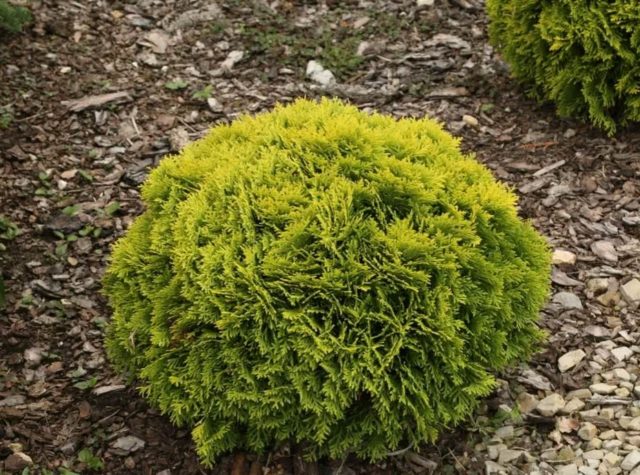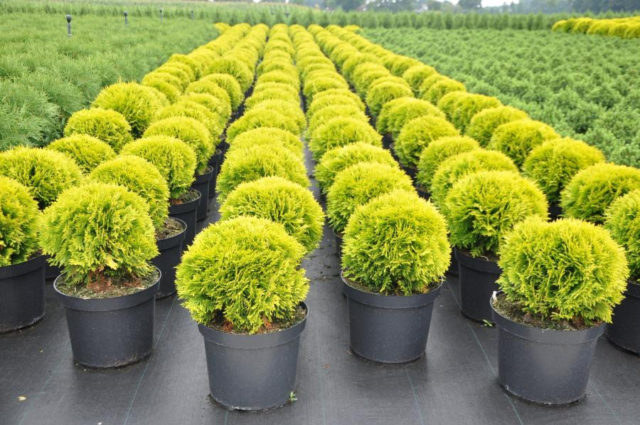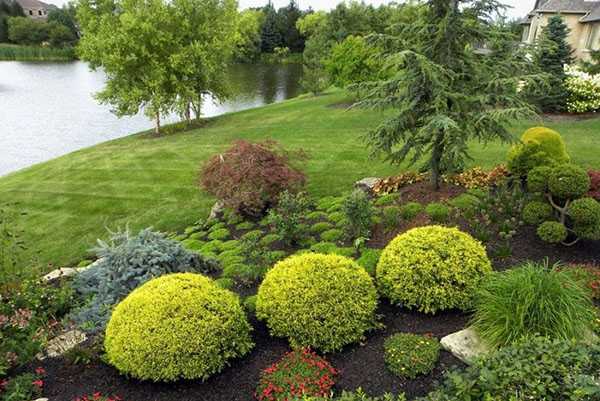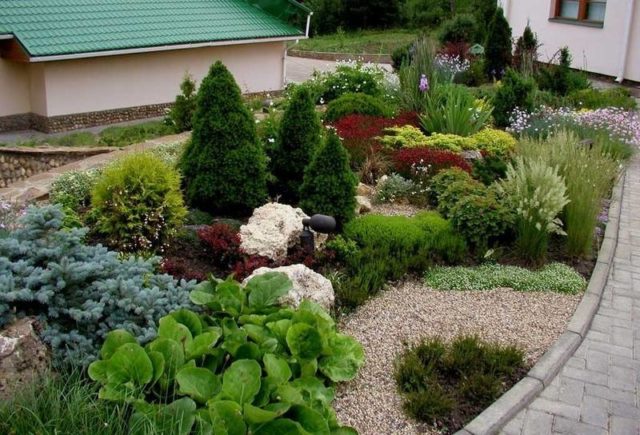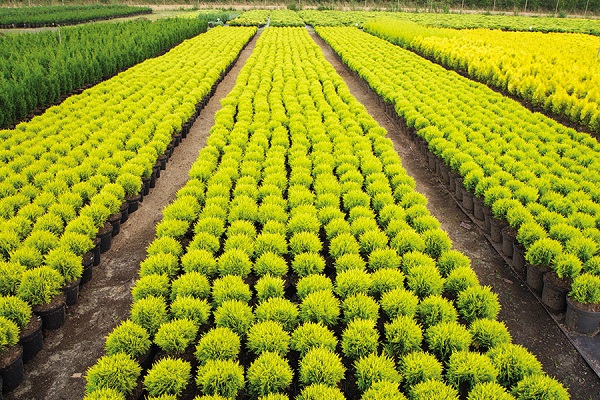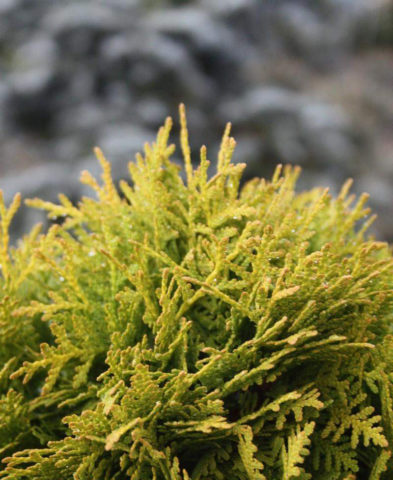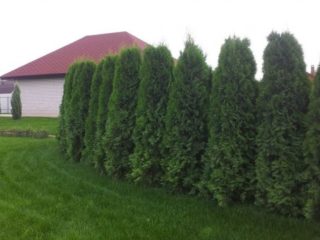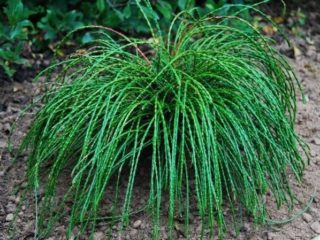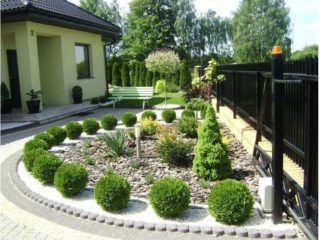Content
Thuja Miriam is a spherical coniferous shrub with an unusual color. The golden crown of the western thuja has gained popularity in Europe. Miriam species was bred as a result of genetic changes in the Danica variety.
Description of western thuja Miriam
According to the description, thuja Miriam (pictured) is a coniferous, dwarf shrub with a decorative color and a spherical crown. The dwarf variety grows rather slowly (5-8 cm per year), the height of an adult ephedra does not exceed 80 cm, the diameter is 0.7 ÷ 0.8 cm.
The crown of thuja western Miriam is dense, regular in shape. Scale needles change color depending on the season. In winter, the needles are bronze, and in spring they turn golden.
From the Danica variety, thuja western Miriam inherited the vertical arrangement of needles. They are tightly adjacent to each other, which creates volume and density.
The use of thuja Miriam in landscape design
Spherical thuja Miriam has found wide application in landscape design. It is used in group plantings with other plants, and is also planted as a tapeworm in small flower beds.
Due to the slow growth of the western thuja, the composition retains its original appearance for a long time, as conceived by the designer, therefore the Miriam variety is often planted in mixborders, Japanese gardens and rock gardens.
Shrubs grow well in pots, with their help you can create an unusual lawn of any configuration. Miriam's spherical thuja containers adorn balconies, terraces and rooftops.
Photos of the use of thuja Miriam in landscape design are presented below.
Breeding features
In nature, thuja reproduce by seeds, but decorative forms, for example, Miriam, are better to breed with other available methods:
- cuttings;
- layering.
Breeding thuja seeds is a very long-term method, as a result of which an ephedra with maternal characteristics does not always grow.
Harvesting cuttings of thuja western Miriam is carried out early in the morning or on a cloudy day. It is better to use twigs that have been torn off, rather than cut off from the mother bush. A "heel" should remain on the handle - a piece of bark from an adult plant, such blanks take root faster.
Cuttings should be semi-lignified, healthy, without lower leaves. For rooting to occur faster and more efficiently, it is necessary to prepare a nutrient mixture consisting of peat and sand, taken in a 1: 1 ratio. Before planting the cuttings, they are immersed for several hours in Kornevin's solution or any drug that stimulates root growth. The cuttings are planted in the ground at an inclination of about 60 degrees, buried in the ground by 3-4 cm. The temperature for rooting should be within 21-23 ° C.
With the help of layering, Miriam thuja is propagated in the open field. To do this, the lower branch is tilted to the ground, secured with a hairpin and sprinkled with earth. The next season, the cuttings should take root, after which it is separated from the mother plant and transplanted.
It is installed next to it, a nutritious substrate is poured, the branch is bent and strengthened with a metal hairpin, and it is covered with earth from above. When the cuttings are rooted, they are separated from the mature plant.
Landing rules
To grow an ephedra with high decorative qualities, certain planting requirements must be observed. Rooting is influenced by the quality of the soil and the planting period, and decorativeness depends on the chosen planting site.
Recommended timing
If Miriam western thuja is purchased in a container, it is planted at any time from April to October. Seedlings with an open root system do not tolerate transplanting well, therefore they are recommended to be planted in the spring so that they have time to take root over the summer.
Site selection and soil preparation
The growth and development of thuja western Miriam seedlings depends on the composition of the soil and sunlight.
For planting thuja seedlings of the western variety Miriam, slightly acidic soil and a well-lit area are suitable. Lack of lighting leads to the fact that the bush loses its spherical shape, the crown stretches and looks unaesthetic. In addition, the golden color of the crown loses its coloring pigment and looks pale.
If the land on the site allocated for planting the thuja of western Miriam is heavy and excessively moist, drainage is required, the layer of which should be at least 20 cm. Gravel, expanded clay, together with sand can be used as drainage material.
Landing algorithm
The size of the planting pit depends on the size of the seedling root system. The roots should fit freely in the hole. Landing is carried out using the following technology:
- preparation of the landing hole;
- drainage device (if necessary);
- installation of a seedling;
- filling the root system with prepared soil, consisting of leafy soil, sand and peat in a ratio of 2: 1: 1. Complex mineral fertilizer can be added to the soil at the rate of 5 g per 1 liter of nutrient mixture;
- watering and mulching the trunk circle.
Growing and care rules
In order for a coniferous seedling to decorate the site for many years, you need to take care of its watering, feeding and pruning, as well as proper preparation for wintering.
Watering schedule
Thuja western Miriam needs regular watering, especially for young seedlings, which react painfully to drying out of the soil and dry air.
1 bush will require about 10 liters of water. Watering is carried out 1-2 times a week, taking into account precipitation and weather in the region. During a drought, the number of irrigations is increased; in addition to moistening the soil, sprinkling is included. The procedure is recommended to be carried out after sunset in order to prevent the appearance of burns on the needles.
Top dressing
Top dressing of thuja western Miriam is carried out in the spring (April-May). For this, complex nutritional compositions are used, for example, Kemira-wagon. For 1 m² of the area of the trunk circle, 50 g of the drug will be required.
In the autumn (late September - October), seedlings are fed with potash.
Pruning
Sanitary pruning is done annually. It is best to postpone this procedure until the spring. In early April, the damaged, frozen branches are cut off.
Formative pruning can be done at the same time as sanitary pruning. The crone is shaped into a sphere.
Preparing for winter
Mature western thuja bushes tolerate winter frosts well. Preparation of a seedling for cold weather should be carried out in October-November. The start of the preparatory work depends on the region. Preparation consists in carrying out the following activities:
- For the winter, the crown is pulled together with a soft ribbon or rope.
- They are covered with a special insulating material (agrospan, spunbond, lutrasil, kraft paper).
- From above, you can build a shelter that will help save the crown during snowfalls. It is made from a film stretched over wooden pegs.
- The shelter is securely fixed so that it does not fly off during strong winds.
- Be sure to insulate the near-trunk circle, for this they pour sawdust or needles in a thick layer, then spruce branches are laid.
Pests and diseases
The decorative appearance of the thuja can be spoiled by the thuja aphid. It damages the lower part of the shoots. To combat aphids, spraying with Karbofos is used.
The speckled moth is a butterfly that affects the plantings of thuja. She starts flying in early summer. You can notice the appearance of moths on the brown tops and dying shoots. Preparations containing pyrethroids will help to eliminate the pest on Miriam's thuja. The treatment is carried out 2-3 times with an interval between treatments of 7-10 days.
To eliminate false shields on Tui Miriam, spraying with Karbofos and Aktellik is used.
A danger to the root system is the click beetle. Acid soil and stagnant moisture become a favorable environment for wireworm larvae. Autumn digging and drainage helps to get rid of pests. If there are many pests, the soil is treated with preparations based on Diazonin.
Thuja diseases include the following:
- brown shoots on Tui Miriam appear due to a fungal infection. The disease can be detected in early spring by yellowed scales. If measures are not taken in a timely manner, the shoots turn brown and die off. The damaged branches are cut off and burned. Thuja seedlings are fed, and the earth is lime. The crown is sprayed several times with an interval of 2 weeks with a 0.2% Fundazole solution;
- soil fungi can provoke fusarium of the roots of thuja Miriam. The seedling is treated with Zircon, which helps to increase resistance to infections, and the fungicides Hom, Kartocid;
- when the shoots dry out, copper-containing agents are used to process the thuja western Miriam.
Conclusion
Tuya Miriam is a dwarf coniferous culture, characterized by a spherical shape and golden color of the crown. An ornamental plant is used in landscape design, it can become a decoration for an alpine slide, with its help they create living borders along garden paths.
